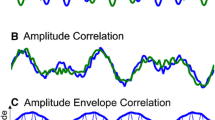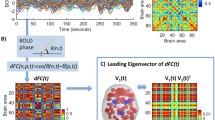Abstract
The relationship between individual characteristics of spontaneous electrical activity of the brain and concentration of attention was studied using the analysis of accuracy in the “Bourdon test” for voluntary attention. The accuracy of test performance was found to correlate with the spectral power and index of the α and θ bands in the left mid-temporal cortical area, as well as an increase in signal connectivity between the mid-temporal and other EEG sites. An increase in the spectral power of the θ band and a decrease in α index led to an increase in the number of errors in the test. On the one hand, the findings possibly indicate that the left mid-temporal region plays a special role organizing the coordinated systemic spatiotemporal interaction of cortical fields, which is necessary for efficient test performance. On the other hand, the findings raise the question as to whether a reorganization of background brain activity is of importance as a precondition of local processes to facilitate further cognitive performance.




Similar content being viewed by others
REFERENCES
Raichle, M.E., MacLeod, A.M., Snyder, A.Z., et al., A default mode of brain function, Proc. Natl. Acad. Sci. U.S.A., 2001, vol. 98, no. 2, p. 676.
Raichle, M.E., Neuroscience. The brain’s dark energy, Science, 2006, vol. 24, no. 5803, p. 1249.
Raichle, M.E., The brain’s default mode network, Annu. Rev. Neurosci., 2015, vol. 38, p. 1433.
Sadaghiani, S., Scheeringa, R., Lehongre, K., et al., Intrinsic connectivity networks, α oscillations, and tonic alertness: a simultaneous electroencephalography/functional magnetic resonance imaging study, J. Neurosci., 2010, vol. 30, no. 30, p. 10243.
Piradov, M.A., Suponeva, N.A., Seliverstov, Yu.A., et al., The opportunities of modern imaging methods in the study of spontaneous brain activity in the rest, Nevrol. Zh., 2016, vol. 21, no. 1, p. 4.
Sadaghiani, S., Hesselmann, G., Friston, K.J., and Kleinschmidt, A., The relation of ongoing brain activity, evoked neural responses, and cognition, Front. Syst. Neurosci., 2010, vol. 4, p. 20.
Sadaghiani, S., Scheeringa, R., Lehongre, K., et al., α-band phase synchrony is related to activity in the fronto-parietal adaptive control network, J. Neurosci., 2012, vol. 32, no. 41, p. 14305.
Seeley, W.W., Menon, V., and Schatzberg, A.F., Dissociable intrinsic connectivity networks for salience processing and executive control, J. Neurosci., 2007, vol. 2, no. 9, p. 2349.
Papo, D., Why should cognitive neuroscientists study the brain’s resting state? Front. Hum. Neurosci., 2013, vol. 7, no. 45, p. 1.
von Stein, A. and Sarnthein, J., Different frequencies for different scales of cortical integration: from local gamma to long range alpha theta synchronization, Int. J. Psychophysiol., 2000, vol. 38, no. 3, p. 301.
Knyazev, G.G., Slobodskoj-Plusnin, J.Y., Bo-charov, A.V., and Pylkova, L.V., The default mode network and EEG alpha oscillations: an independent component analysis, Brain Res., 2011, vol. 1402, p. 67.
Smit, D.J.A., Posthuma, D., Boomsma, D.I., and de Geus, E.J.C., Heritability of back ground EEG across the power spectrum, Psychophysiology, 2005, vol. 42, p. 691.
van Beijsterveldt, C.E.M. and van Baal, G.C.M., Twin and family studies of the human electroencephalogram: a review and a meta-analysis, Biol. Psychol., 2002, vol. 62, p. 111.
Barvinok, A.I. and Rozhkov, V.P., Intercentral coordination of cortical electrical processes with mental activity, Fiziol. Chel., 1992, vol. 18, no. 3, p. 5.
Andronnikova, E.A. and Zaika, E.V., Metody issledovaniya vospriyatiya, vnimaniya i pamyati: rukovodstvo dlya prakticheskikh psikhologov (Analysis of Perception, Attention, and Memory: Manual for Plasticizing Psychologists), Kharkov: Khark. Nats. Univ. im. V.N. Karazina, 2011.
Parks, E.L. and Madden, D.J., Brain connectivity and visual attention, Brain Connect., 2013, vol. 3, no. 1, p. 317.
Baars, B.J. and Gage, N.M., Cognition, Brain, and Consciousness: Introduction to Cognitive Neuroscience, Amsterdam: Elsevier, 2007.
Shelepin, Yu.E., Fokin, V.A., Men’shikova, S.V., et al., Use of methods of icons and brain mapping to evaluate the functional state of the visual system, Sens. Sist., 2014, vol. 28, no. 2, p. 63.
Shevelev, A.I., Neirony-detektory zritel’noi kory (Neurons-Detectors of the Visual Cortex), Moscow: Nauka, 2010.
Roe, A.W., Chelazzi, L., Connor, C.E., et al., Toward a unified theory of visual area V4, Neuron, 2012, vol. 74, no. 1, p. 12.
Shioiri, S., Honjyo, H., Kashiwase, Y., et al., Visual attention spreads broadly but selects information locally, Sci. Rep., 2016, vol. 6, art. ID 35513.
Rolls, E.T., Invariant visual object and face recognition: neural and computational bases, and a model, VisNet, Front. Comput. Neurosci., 2012, vol. 6, p. 35.
Baldassarre, A., Lewis, C.M., Committeri, G., et al., Individual variability in functional connectivity predicts performance of a perceptual task, Proc. Natl. Acad. Sci. U.S.A., 2012, vol. 109, no. 9, p. 3516.
Vygotskii, L.S., Razvitie vysshikh psikhicheskikh funktsii (Development of Higher Mental Functions), Moscow: Akad. Pedagog. Nauk RSFSR, 1960.
Klimesch, W., Alpha-band oscillations, attention, and controlled access to stored information, Trends Cognit. Sci., 2012, vol. 16, no. 12, p. 606.
Eismont, E.V., Kaida, A.I., and Bakunova, A.V., Relationship between EEG parameters and the level of development of voluntary attention in 5–9 years old children, Uch. Zap. Krymsk. Fed. Univ. im. V.I. Verndaskogo, Biol., Khim., 2015, vol. 1, no. 4, p. 89.
Iemi, L., Chaumon, M., Crouzet, S.M., and Busch, N.A., Spontaneous neural oscillations bias perception by modulating baseline excitability, J. Neurosci., 2017, vol. 37, no. 4, p. 807.
Pavlova, L.P., Dominanty deyatel’nogo mozga cheloveka: Sistemnyi pasikhofiziologicheskii podkhod k analizu EEG (Dominants of Human Brain Activity: System Psychophysiological Approach to EEG Analysis), St. Petersburg: Inform-Navigator, 2017.
Klimesch, W., EEG alpha and theta oscillations reflect cognitive and memory performance: a review and analysis, Brain Res. Rev., 1999, vol. 29, p. 169.
van der Hiele, K., Vein, A.A., Reijntjes, R.H.A.M., et al., EEG correlates in the spectrum of cognitive decline, Clin. Neurophysiol., 2007, vol. 118, no. 9, p. 1931.
Sugrobova, G.A., Semenova, O.A., and Machinskaya, R.I., Regulatory and information components of cognitive activity in 7–8 years old children with ADHD, Ekol. Chel., 2010, no. 11, p. 19.
Hermens, D.F., Soei, E.X., Clarke, S.D., et al., Resting EEG theta activity predicts cognitive performance in attention-deficit hyperactivity disorder, Pediatr. Neurol., 2005, vol. 32, no. 4, p. 248.
Author information
Authors and Affiliations
Corresponding author
Additional information
ALEKSANDR NIKOLAEVICH SHEPOVALNIKOV is a merited scientist, doctor of science (medicine). His research have always been associated with Sechenov Institute of Evolutionary Physiology and Biochemistry, where he went from being a junior researcher to head of the Laboratory of Children’s Neurophysiology and leader of the Section of Evolution of Higher Nervous Activity. Shepovalnikov’s research interests range broadly from pressing problems of age-related physiology to problems of the physiology of sleep and biocybernetics. However, the formation of systemic brain activity during postnatal development has always been the main field of his research. Professor Shepovalnikov is a talented teacher and pays substantial attention to working with the young and contributing to the popularity of science. The Editorial Board of Human Physiology congratulate their regular author and active member Aleksandr Shepovalnikov with his jubilee and wish him good health and every success with his plans and ideas in research and personal life.
Translated by T. Tkacheva
Rights and permissions
About this article
Cite this article
Stankova, E.P., Shepovalnikov, A.N. Functional Connectivity of Cortical Fields at Rest as a Mechanism of Brain Preparation to Purposeful Activity. Hum Physiol 44, 609–616 (2018). https://doi.org/10.1134/S0362119718060129
Received:
Published:
Issue Date:
DOI: https://doi.org/10.1134/S0362119718060129




